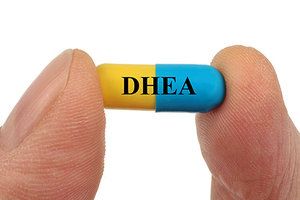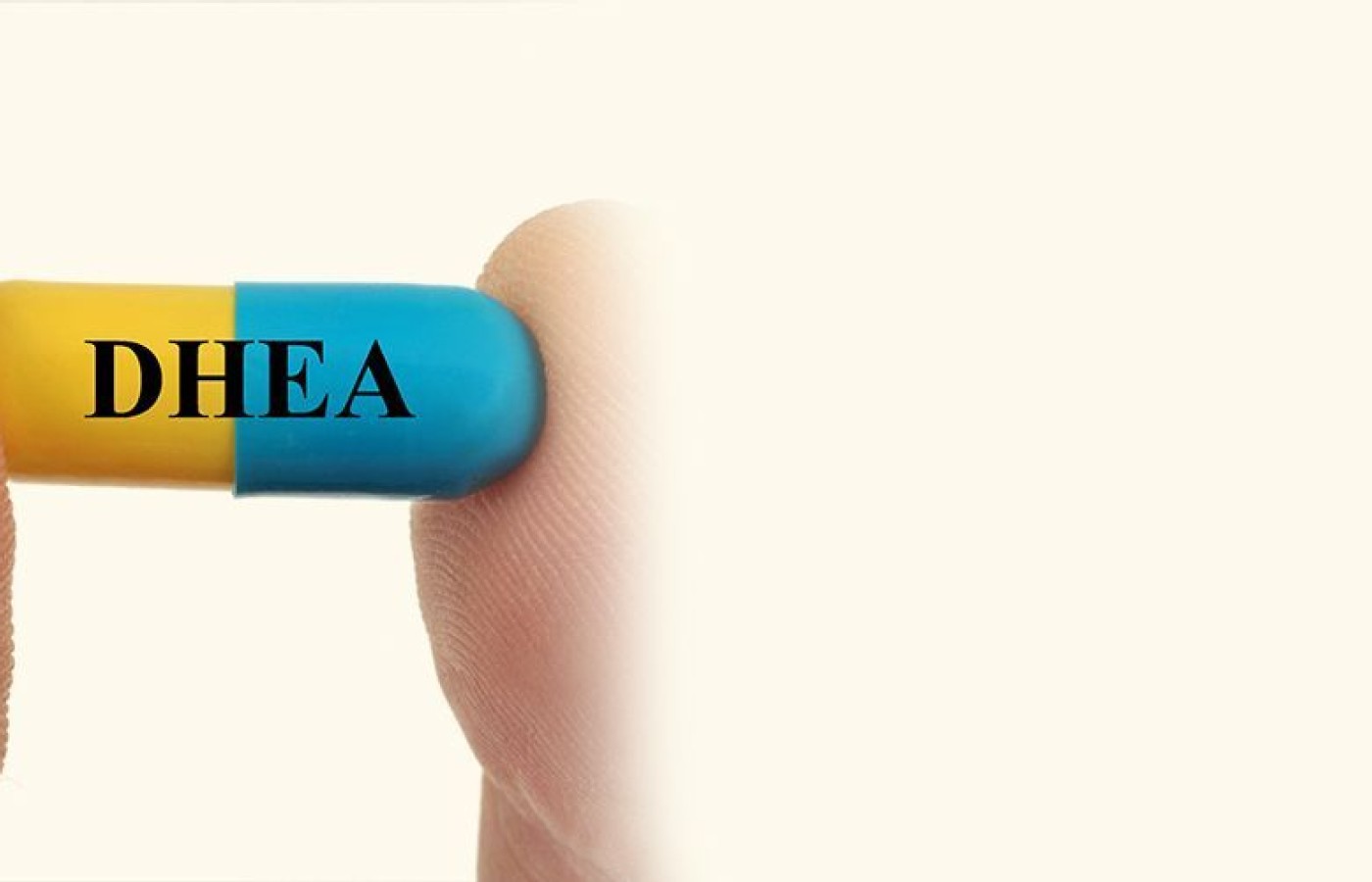One of the longest nerves in the body is known as the vagus nerve (VN). The VN is the 10th pair of cranial nerves that originates at the brain stem in the medulla oblongata. This nerve is part of the parasympathetic nervous system, which is a part of the ANS. Research suggests ear acupuncture can activate the VN.
DHEA: A Key to Eternal Youth?
DHEA and its sulfated form, DHEA-S, are the most abundant steroid hormones in the human body.1 They are primarily produced in the adrenal cortex, with smaller amounts of DHEA being synthesized in the ovaries and testes. DHEA is a precursor to estradiol, estrone, testosterone and 5α-dihydrotestosterone (5α-DHT).2 As an androgen, DHEA has roughly 1/20th of the androgen potency of testosterone.3
Much like estrogen and testosterone, levels of DHEA and DHEA-S decrease with age and are approximately 25 percent of their peak by age 70.4 Thus, we see substantial research regarding DHEA and its supplementation surrounding common concerns with aging: libido, bone health, body composition, metabolism, and skin integrity and appearance.
DHEA and Aging

In a randomized, double-blind, placebo-controlled trial, 280 senior men and women were given 50 mg of DHEA or placebo daily for a year.4 With supplementation, DHEA-S was restored to "normal youthful levels" in both sexes. In men, there was no significant increase in testosterone, while in women, testosterone levels were significantly higher by month six. There was a trend of increasing estradiol levels in men at month 12, while in women, this increase was significant, with levels falling within normal ranges of the early follicular phase of menstruating women.
In this study, numerous clinical parameters were assessed. DHEA supplementation positively affected bone health, decreasing bone turnover in women over age 70, and significantly improved most parameters related to libido in this age group of the women as well. In all individuals taking DHEA, there was a significant increase in skin hydration and sebum levels, and facial yellowness decreased. There also was a significant increase in epidermal thickness on the dorsal hand in the individuals having DHEA-S levels in the lowest quartile initially.
Additional studies in seniors have shown that long-term DHEA supplementation at 50 mg/day for six months to two years may decrease insulin resistance, triglycerides, and levels of pro-inflammatory cytokines;5 enhance the effects of weight training on muscle mass;6 decrease arterial stiffness;7 improve bone mineral density;8 and decrease visceral and subcutaneous fat.9 At a dose of 25 mg/day for six months, DHEA supplementation also improved cognitive scores in women with mild to moderate cognitive impairment.10 In these studies,4-10 no serious adverse events attributed to DHEA supplementation were reported.
DHEA and Libido
In addition to the findings in women age 70 and older, DHEA may improve libido in younger females as well. In post-menopausal women age 50-60, DHEA at the low dose of only 10 mg a day for 12 months was shown to significantly improve sexual function and frequency compared to the control intervention.11 In a population of men and women with hypoactive sexual desire disorder, at a dose of 100 mg/day for six weeks, treatment with DHEA significantly improved sexual arousal and satisfaction in women; however, in the men no improvements were seen.12
It is not uncommon for women to have sexual side effects from oral contraceptive (OC) use, with a small, but still substantial percentage having a decline in libido.13 In women taking OCs, the addition of 50 mg of DHEA daily significantly improved numerous markers of sexual function which had declined with initiation of the OC medication.14 The women who had higher free testosterone levels during DHEA administration were found to experience greater effects of DHEA on sexual arousal and desire.
DHEA and Erectile Dysfunction
Multiple population studies have shown an inverse relationship between DHEA levels and the incidence of erectile dysfunction (ED).15-16 In addition to being a testosterone precursor, DHEA's demonstrated anti-inflammatory effects and action of enhancing blood vessel dilation further suggest it may be useful for the treatment of ED.17 Two studies have shown significant improvements in International Index of Erectile Function scores when DHEA was taken at 50 mg/day for a six-month period.18-19
Potential Adverse Effects
With DHEA, mild adverse effects are typically not seen acutely, but can be with prolonged use. Testing of DHEA levels to ensure they are not high or in the high-normal range prior to treatment may help prevent untoward effects. Adverse effects are mild and include complaints of oily skin, hair growth, acne, and body odor20-21 – things we typically associate with increased testosterone levels. However, hair loss can also be seen because DHEA converts to more potent androgens in the hair follicle, which can interfere with hair growth.22
Long-term studies have shown DHEA did not have adverse effects on prostate markers.4,19 In elderly women, a small, yet significant, increase in estradiol levels has been seen with daily supplementation of 50 mg of DHEA; however, in the studies that also considered mammography and pap smear results, there was not an increase in abnormalities.
Typically, DHEA is initiated at a low dose, and if there are not adverse effects, the dose is gradually increased to levels shown to be effective in clinical studies. Males are generally more tolerant to higher doses of DHEA, likely due to its pro-androgen effects.
The findings of the studies overall are well-summarized in the conclusion statements about the one-year study of seniors:4 "A number of biological indices confirmed the lack of harmful consequences of this 50 mg/day DHEA administration over one year, also indicating that this kind of replacement therapy normalized some effects of aging."
References
- Nieschlag E, et al. The secretion of dehydroepiandrosterone and dehydroepiandrosterone sulphate in man. J Endocrinol, 1973 Apr;57(1):123-34.
- Legrain S, et al. Dehydroepiandrosterone replacement administration: pharmacokinetic and pharmacodynamic studies in healthy elderly subjects. J Clin Endocrinol Metab, 2000 Sep;85(9):3208-17.
- Sadovsky R. Androgen deficiency in women: review of the subject. Am Fam Phys, 2001 Dec 15;64(12):2009.
- Baulieu EE, et al. Dehydroepiandrosterone (DHEA), DHEA sulfate, and aging: contribution of the DHEAge Study to a sociobiomedical issue. Proc Natl Acad Sci (USA), 2000 Apr 11;97(8):4279-84.
- Weiss EP, et al. Dehydroepiandrosterone (DHEA) replacement decreases insulin resistance and lowers inflammatory cytokines in aging humans. Aging, 2011 May;3(5):533-42.
- Villareal DT, Holloszy JO. DHEA enhances effects of weight training on muscle mass and strength in elderly women and men. Am J Physiol Endocrinol Metab, 2006 Nov;291(5):E1003-8.
- Weiss EP, et al. Dehydroepiandrosterone replacement therapy in older adults improves indices of arterial stiffness. Aging Cell, 2012 Oct;11(5):876-84.
- Jankowski CM, et al. Effects of dehydroepiandrosterone replacement therapy on bone mineral density in older adults: a randomized, controlled trial. J Clin Endocrinol Metab, 2006 Aug;91(8):2986-93.
- Villareal DT, Holloszy JO. Effect of DHEA on abdominal fat and insulin action in elderly women and men: a randomized controlled trial. JAMA, 2004 Nov 10;292(18):2243-8.
- Yamada S, et al. Effects of dehydroepiandrosterone supplementation on cognitive function and activities of daily living in older women with mild to moderate cognitive impairment. Geriatr Gerontol Int, 2010 Oct;10(4):280-7.
- Genazzani AR, et al. Effect of 1-year, low-dose DHEA therapy on climacteric symptoms and female sexuality. Climacteric, 2011 Dec;14(6):661-8.
- Bloch M, et al. The use of dehydroepiandrosterone in the treatment of hypoactive sexual desire disorder: a report of gender differences. Eur Neuropsychopharmacol, 2013 Aug;23(8):910-8.
- Burrows LJ, et al. The effects of hormonal contraceptives on female sexuality: a review. J Sex Med, 2012 Sep;9(9):2213-23.
- van Lunsen RHW, et al. Maintaining physiologic testosterone levels during combined oral contraceptives by adding dehydroepiandrosterone: II. Effects on sexual function. A phase II randomized, double-blind, placebo-controlled study. Contraception, 2018 Jul;98(1):56-62.
- Reiter WJ, et al. Serum dehydroepiandrosterone sulfate concentrations in men with erectile dysfunction. Urology, 2000 May;55(5):755-8.
- Feldman HA, et al. Impotence and its medical and psychosocial correlates: results of the Massachusetts Male Aging Study. J Urol, 1994 Jan;151(1):54-61.
- El-Sakka AI. Dehydroepiandrosterone and erectile function: a review. World J Mens Health, 2018 Sep;36(3):183-191.
- Seftel A. Dehydroepiandrosterone in the treatment of erectile dysfunction in patients with different organic etiologies. J Urol, 2002 Aug;168(2):867-8.
- Reiter WJ, et al. Dehydroepiandrosterone in the treatment of erectile dysfunction: a prospective, double-blind, randomized, placebo-controlled study. Urology, 1999 Mar;53(3):590-4.
- Løvås K, et al. Replacement of dehydroepiandrosterone in adrenal failure: no benefit for subjective health status and sexuality in a 9-month, randomized, parallel group clinical trial. J Clin Endocrinol Metab, 2003 Mar;88(3):1112-8.
- Finckh A, et al. A randomized controlled trial of dehydroepiandrosterone in postmenopausal women with fibromyalgia. J Rheumatol, 2005 Jul;32(7):1336-40.
- Kasick JM, et al. Adrenal androgenic female-pattern alopecia: sex hormones and the balding woman. Cleve Clin Q, 1983 Summer;50(2):111-22.



